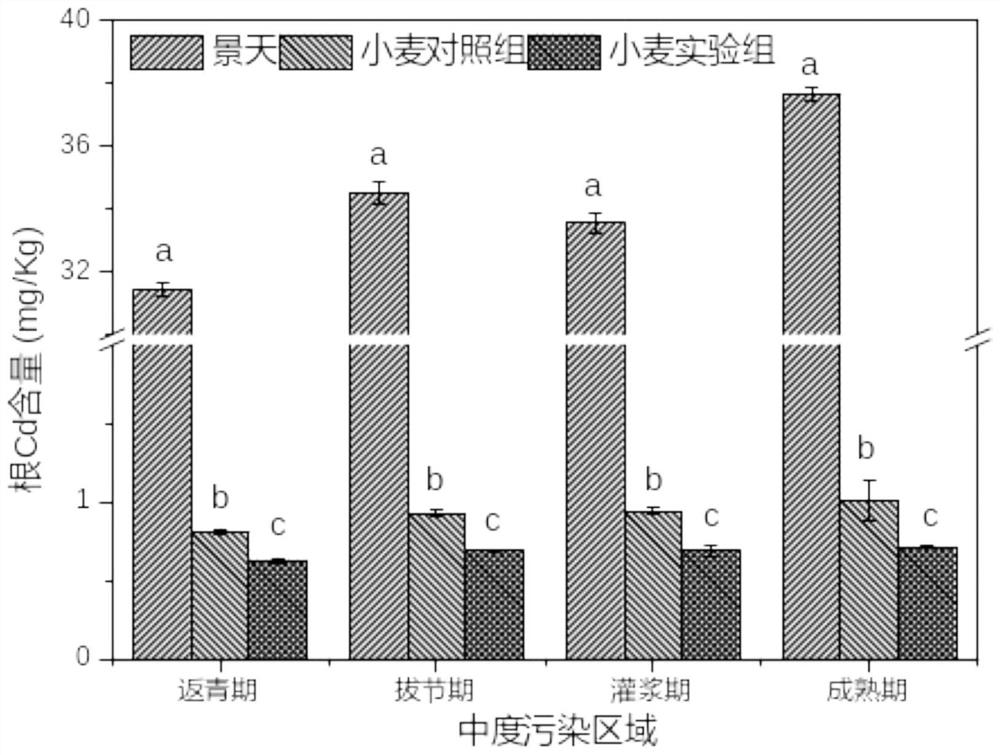Method for safely utilizing red-spotted stonecrop and wheat intercropping and repairing cadmium-polluted soil
A cadmium-contaminated soil and cadmium-contaminated technology, which is applied in the field of environmental pollution control, can solve the problems of parallel remediation of cadmium-contaminated soil without research on the safe use of cadmium-contaminated soil, and no overall consideration of plants, etc., to achieve the effects of reduced migration, large adsorption capacity, and large specific surface area
- Summary
- Abstract
- Description
- Claims
- Application Information
AI Technical Summary
Problems solved by technology
Method used
Image
Examples
Embodiment 1
[0044] A method for safely using sedum-wheat intercropping and repairing cadmium-contaminated soil comprises the following steps:
[0045] Sedum-winter wheat intercropping:
[0046] (1) Planting of winter wheat: set up several planting belts, plant 4 rows of winter wheat at equal row spacing in October on the soil of the cadmium-contaminated planting zone, and the row spacing of winter wheat is 50cm;
[0047] (2) Sedum seedling cultivation: after the sedum seeds were processed, seedlings were raised to a plant height of 10 cm in the greenhouse;
[0048] (3) Sedum sedum transplanting: Sedum sedum is planted between the winter wheat rows in March of the second year during the period of winter wheat turning green, and the wheat row and the sedum row are spaced at 25cm;
[0049] (4) field management: water in time after the intercropping sedum, apply 200kg / ha of compound fertilizer simultaneously, then carry out conventional watering and irrigation;
[0050] (5) Harvesting: whea...
Embodiment 2
[0059] A method for safely using sedum-wheat intercropping and repairing cadmium-contaminated soil comprises the following steps:
[0060] Sedum-winter wheat intercropping:
[0061] (1) Planting of winter wheat: set up several planting belts, plant 4 rows of winter wheat at equal row spacing in October on the soil of the cadmium-contaminated planting zone, and the row spacing of winter wheat is 50cm;
[0062] (2) Sedum seedling cultivation: after the sedum seeds were processed, the seedlings were raised in the greenhouse to a plant height of 11 cm;
[0063] (3) Sedum sedum transplanting: Sedum sedum is planted between the winter wheat rows in March of the second year during the period of winter wheat turning green, and the wheat row and the sedum row are spaced at 25cm;
[0064] (4) field management: water in time after the intercropping sedum, apply 200kg / ha of compound fertilizer simultaneously, then carry out conventional watering and irrigation;
[0065] (5) Harvesting: ...
Embodiment 3
[0074] A method for safely using sedum-wheat intercropping and repairing cadmium-contaminated soil comprises the following steps:
[0075] Sedum-winter wheat intercropping:
[0076] (1) Planting of winter wheat: set up several planting belts, plant 4 rows of winter wheat at equal row spacing in October on the soil of the cadmium-contaminated planting zone, and the row spacing of winter wheat is 50cm;
[0077] (2) Sedum seedling cultivation: after the Sedum sedum seeds were processed, the seedlings were raised in the greenhouse to a plant height of 12 cm;
[0078] (3) Sedum sedum transplanting: Sedum sedum is planted between the winter wheat rows in March of the second year during the period of winter wheat turning green, and the wheat row and the sedum row are spaced at 25cm;
[0079] (4) field management: water in time after the intercropping sedum, apply 200kg / ha of compound fertilizer simultaneously, then carry out conventional watering and irrigation;
[0080] (5) Harves...
PUM
 Login to View More
Login to View More Abstract
Description
Claims
Application Information
 Login to View More
Login to View More - R&D
- Intellectual Property
- Life Sciences
- Materials
- Tech Scout
- Unparalleled Data Quality
- Higher Quality Content
- 60% Fewer Hallucinations
Browse by: Latest US Patents, China's latest patents, Technical Efficacy Thesaurus, Application Domain, Technology Topic, Popular Technical Reports.
© 2025 PatSnap. All rights reserved.Legal|Privacy policy|Modern Slavery Act Transparency Statement|Sitemap|About US| Contact US: help@patsnap.com



